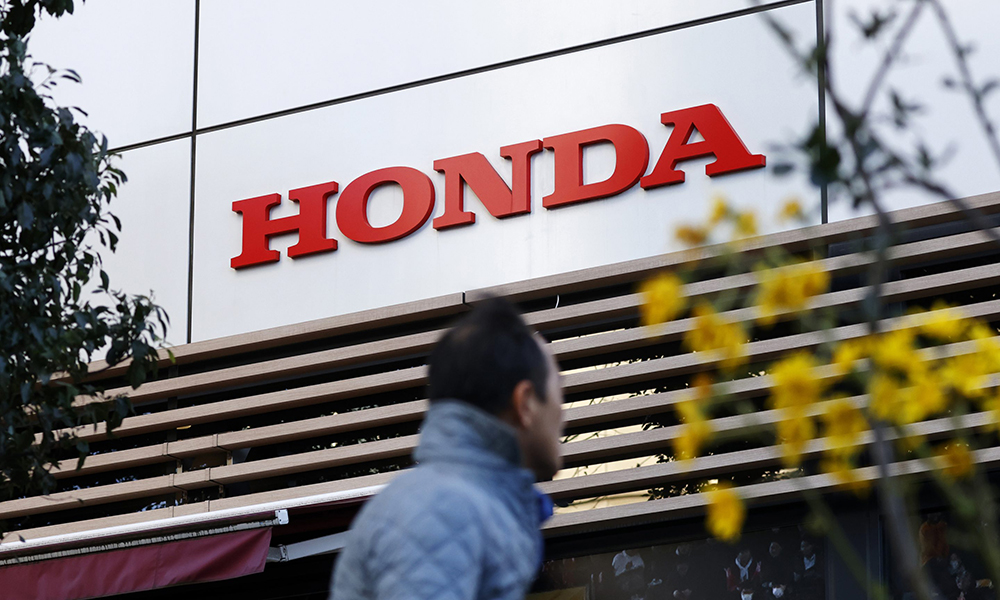
本田汽车(Honda Motor Co.)与日产汽车(Nissan Motor Co.)正在进行合并谈判,背后一个突出的原因是它们在中国市场的节节败退。
日本汽车厂商曾经作为高品质汽车供应商在中国市场占据了主导地位,但比亚迪(BYD Co.)和其他汽车厂商生产的电动汽车和混合动力汽车大受欢迎,让日本汽车厂商风光不再。这导致日本厂商为满足全球最大汽车市场的国内需求而建设的本地工厂产能严重过剩。
麦格理证券韩国有限公司(Macquarie Securities Korea Ltd.)的分析师詹姆斯·洪表示:“看看本田和日产,他们一直在丢失市场份额。我们预计两家公司都将大幅削减产能,从而至少覆盖在中国的一些固定成本负担。”
在截至3月的财政年度内,日产在中国生产了779,756辆汽车,约为近年来峰值产量的一半。花旗集团全球市场(Citigroup Global Markets )分析师吉田有文表示,总部位于横滨的日产汽车已经启动了一项成本削减计划,将全球产能削减五分之一至400万辆,其中中国占100万辆产能削减量的一半。
本田在7月份表示,将在中国关闭工厂并减少20%的产能。本田执行副总裁青山真司上个月表示,该汽车制造商正在与中国当地合作伙伴就进一步削减产能进行谈判。
总体而言,自从2018年年末前董事长卡洛斯·戈恩被罢免和逮捕之后,日产汽车就一直处于混乱的状态。多次管理层改组和过时的产品线也导致其市值缩水,成为日本第五大汽车制造商,市值约为1.6万亿日元(102亿美元)。
这使得日产成为潜在的收购目标。
在中国台湾的iPhone手机生产商鸿海精密工业股份有限公司(Hon Hai Precision Industry Co.,又名“富士康”)接触日产讨论收购其股份后,本田与日产似乎加快了合并谈判的进程,不过上周一位知情人士表示,在两家日本公司进行任何谈判期间,富士康搁置了收购日产汽车的意向。
无论如何,人们早已期待着甚至探讨过本田和日产合并的可能性,人们预测日本汽车行业逐渐形成两个阵营:一个阵营包括本田和日产两家厂商,另外一个阵营则由丰田汽车(Toyota Motor Corp.)公司集团控制。
日本共同社周末援引未具名人士的消息称,日产和本田正在考虑建立制造合作伙伴关系,在彼此的工厂生产汽车。本田还将研究为日产生产混合动力汽车的可能性。在美国,混合动力汽车需求强劲,因此日产同样面临困境。
在中国处境艰难的不仅仅是日本汽车制造商。通用汽车公司(General Motors Co.)的中国业务面临50亿美元的成本和减值,而通用正在试图扭转曾经盈利的业务。德国的大众汽车(Volkswagen AG)、宝马(BMW)和梅赛德斯(Mercedes)同样因为未能跟上技术趋势而陷入困境。
日产预计在本财年将生产320万辆汽车,远低于其每年500万辆的产能水平。日产执行副总裁坂本秀行在11月告诉分析师,尽管这意味着产能利用率只有64%,但除了中国市场以外,产能利用率提高到约73%。
彭博智库(Bloomberg Intelligence)高级分析师吉田达夫表示,人们普遍认为,传统汽车厂商的最佳产能利用率不低于80%。
日产首席执行官内田诚曾承诺在未来三年内将全球年销量增加100万辆。七个月后,他在上个月宣布公司重组措施时收回了这一承诺。尽管他计划裁员并可能关闭工厂,但他没有透露具体在哪些地方执行这些计划。
日产副总裁坂本表示,日产已经在调整生产速度和轮班安排,同时整合新旧生产线。栃木工厂引入的下一代生产技术将部署到其他工厂,以节省人力成本。他表示,这些措施将在明年初见成效。
吉田达夫表示:“我不会说中国市场对日本制造商来说永远不再是一个有利可图的市场。但当前的局面在未来三到五年内不会好转。”(财富中文网)
译者:刘进龙
审校:汪皓
本田汽车(Honda Motor Co.)与日产汽车(Nissan Motor Co.)正在进行合并谈判,背后一个突出的原因是它们在中国市场的节节败退。
日本汽车厂商曾经作为高品质汽车供应商在中国市场占据了主导地位,但比亚迪(BYD Co.)和其他汽车厂商生产的电动汽车和混合动力汽车大受欢迎,让日本汽车厂商风光不再。这导致日本厂商为满足全球最大汽车市场的国内需求而建设的本地工厂产能严重过剩。
麦格理证券韩国有限公司(Macquarie Securities Korea Ltd.)的分析师詹姆斯·洪表示:“看看本田和日产,他们一直在丢失市场份额。我们预计两家公司都将大幅削减产能,从而至少覆盖在中国的一些固定成本负担。”
在截至3月的财政年度内,日产在中国生产了779,756辆汽车,约为近年来峰值产量的一半。花旗集团全球市场(Citigroup Global Markets )分析师吉田有文表示,总部位于横滨的日产汽车已经启动了一项成本削减计划,将全球产能削减五分之一至400万辆,其中中国占100万辆产能削减量的一半。
本田在7月份表示,将在中国关闭工厂并减少20%的产能。本田执行副总裁青山真司上个月表示,该汽车制造商正在与中国当地合作伙伴就进一步削减产能进行谈判。
总体而言,自从2018年年末前董事长卡洛斯·戈恩被罢免和逮捕之后,日产汽车就一直处于混乱的状态。多次管理层改组和过时的产品线也导致其市值缩水,成为日本第五大汽车制造商,市值约为1.6万亿日元(102亿美元)。
这使得日产成为潜在的收购目标。
在中国台湾的iPhone手机生产商鸿海精密工业股份有限公司(Hon Hai Precision Industry Co.,又名“富士康”)接触日产讨论收购其股份后,本田与日产似乎加快了合并谈判的进程,不过上周一位知情人士表示,在两家日本公司进行任何谈判期间,富士康搁置了收购日产汽车的意向。
无论如何,人们早已期待着甚至探讨过本田和日产合并的可能性,人们预测日本汽车行业逐渐形成两个阵营:一个阵营包括本田和日产两家厂商,另外一个阵营则由丰田汽车(Toyota Motor Corp.)公司集团控制。
日本共同社周末援引未具名人士的消息称,日产和本田正在考虑建立制造合作伙伴关系,在彼此的工厂生产汽车。本田还将研究为日产生产混合动力汽车的可能性。在美国,混合动力汽车需求强劲,因此日产同样面临困境。
在中国处境艰难的不仅仅是日本汽车制造商。通用汽车公司(General Motors Co.)的中国业务面临50亿美元的成本和减值,而通用正在试图扭转曾经盈利的业务。德国的大众汽车(Volkswagen AG)、宝马(BMW)和梅赛德斯(Mercedes)同样因为未能跟上技术趋势而陷入困境。
日产预计在本财年将生产320万辆汽车,远低于其每年500万辆的产能水平。日产执行副总裁坂本秀行在11月告诉分析师,尽管这意味着产能利用率只有64%,但除了中国市场以外,产能利用率提高到约73%。
彭博智库(Bloomberg Intelligence)高级分析师吉田达夫表示,人们普遍认为,传统汽车厂商的最佳产能利用率不低于80%。
日产首席执行官内田诚曾承诺在未来三年内将全球年销量增加100万辆。七个月后,他在上个月宣布公司重组措施时收回了这一承诺。尽管他计划裁员并可能关闭工厂,但他没有透露具体在哪些地方执行这些计划。
日产副总裁坂本表示,日产已经在调整生产速度和轮班安排,同时整合新旧生产线。栃木工厂引入的下一代生产技术将部署到其他工厂,以节省人力成本。他表示,这些措施将在明年初见成效。
吉田达夫表示:“我不会说中国市场对日本制造商来说永远不再是一个有利可图的市场。但当前的局面在未来三到五年内不会好转。”(财富中文网)
译者:刘进龙
审校:汪皓
Among the reasons for Honda Motor Co. to enter merger talks with Nissan Motor Co., one looms large: China.
The surging popularity of electric and hybrid vehicles made by BYD Co. and others has erased the leading position that Japan’s automakers once enjoyed as providers of high-quality cars with cachet. That’s left them with too much capacity in local factories that were built to satisfy anticipated domestic demand in the world’s largest market for automobiles.
“When you look at Honda and Nissan, they’ve been losing the market for some time,” said James Hong, an analyst at Macquarie Securities Korea Ltd. “We expect both to come up with very large capacity cuts to at least cover some of the fixed-cost burdens they have in China.”
Nissan made 779,756 cars in China during the fiscal year that ended in March, about half of its peak output in recent years. The Yokohama-based firm has embarked on a cost-cutting plan that will slash global capacity by a fifth to 4 million vehicles, with China accounting for more than half of the 1 million-unit reduction, according to Citigroup Global Markets analyst Arifumi Yoshida.
Honda said in July that it will close factories and reduce capacity by 20% in China. The carmaker is in negotiations with local partners on further cuts, Executive Vice President Shinji Aoyama said last month.
More broadly, Nissan has been in a state of turmoil since the late 2018 arrest and ouster of former Chairman Carlos Ghosn. Multiple management shakeups and an outdated product lineup have also contributed to shink it to Japan’s fifth-largest automaker by market value, at around ¥1.6 trillion ($10.2 billion).
That’s made Nissan a potential takeover target.
Efforts to engage in merger talks appear to have accelerated after Hon Hai Precision Industry Co., the Taiwan-based producer of iPhones known as Foxconn, approached Nissan about acquiring a stake in the company, although a person familiar with the matter said last week its interest is on hold while any negotiations between the two Japanese companies continue.
Regardless, a combination of Honda and Nissan has long been anticipated, and even explored, in the past, with the Japanese auto industry coalescing into two camps: One including the two carmakers and another controlled by the Toyota Motor Corp. group of companies.
A Kyodo report over the weekend citing people that weren’t identified said Nissan and Honda are considering a manufacturing partnership in which they will build vehicles at each other’s plants. Honda will also study possibly producing hybrid vehicles for Nissan, which is also struggling in the US where the demand for those sort of cars is strong.
Japanese automakers aren’t the only ones suffering in China. General Motors Co. is facing $5 billion in charges and writedowns related to its operations in the country as it seeks to turn around a once-profitable business. Germany’s Volkswagen AG, along with BMW and Mercedes, are also struggling after falling behind on technology trends.
Nissan expects to produce 3.2 million vehicles during its current fiscal year, well below its ability to produce 5 million units annually. While that translates to a capacity utilization rate of 64%, excluding China, the rate improves to around 73%, Nissan Executive Vice President Hideyuki Sakamoto told analysts in November.
Optimal capacity utilization rates for legacy automakers is widely considered to be at more than 80%, according to Tatsuo Yoshida, senior analyst at Bloomberg Intelligence.
Seven months after pledging to increase annual global sales by 1 million units over the next three years, Nissan Chief Executive Officer Makoto Uchida walked that back when announcing the company’s restructuring measures last month. Despite the planned job cuts and potential plant closures, he hasn’t given details of where they might happen.
Nissan is already adjusting production speeds and work-shift schedules while integrating old lines with newer ones, Vice President Sakamoto said. Next-generation production technology introduced at its Tochigi plant will be deployed at other facilities to save on headcount. These measures should start to deliver results as soon as next year, he said.
“I wouldn’t say the Chinese market won’t ever be a lucrative one for Japanese manufacturers,” Yoshida said. “But it’s not going to happen during the next three to five years.”






